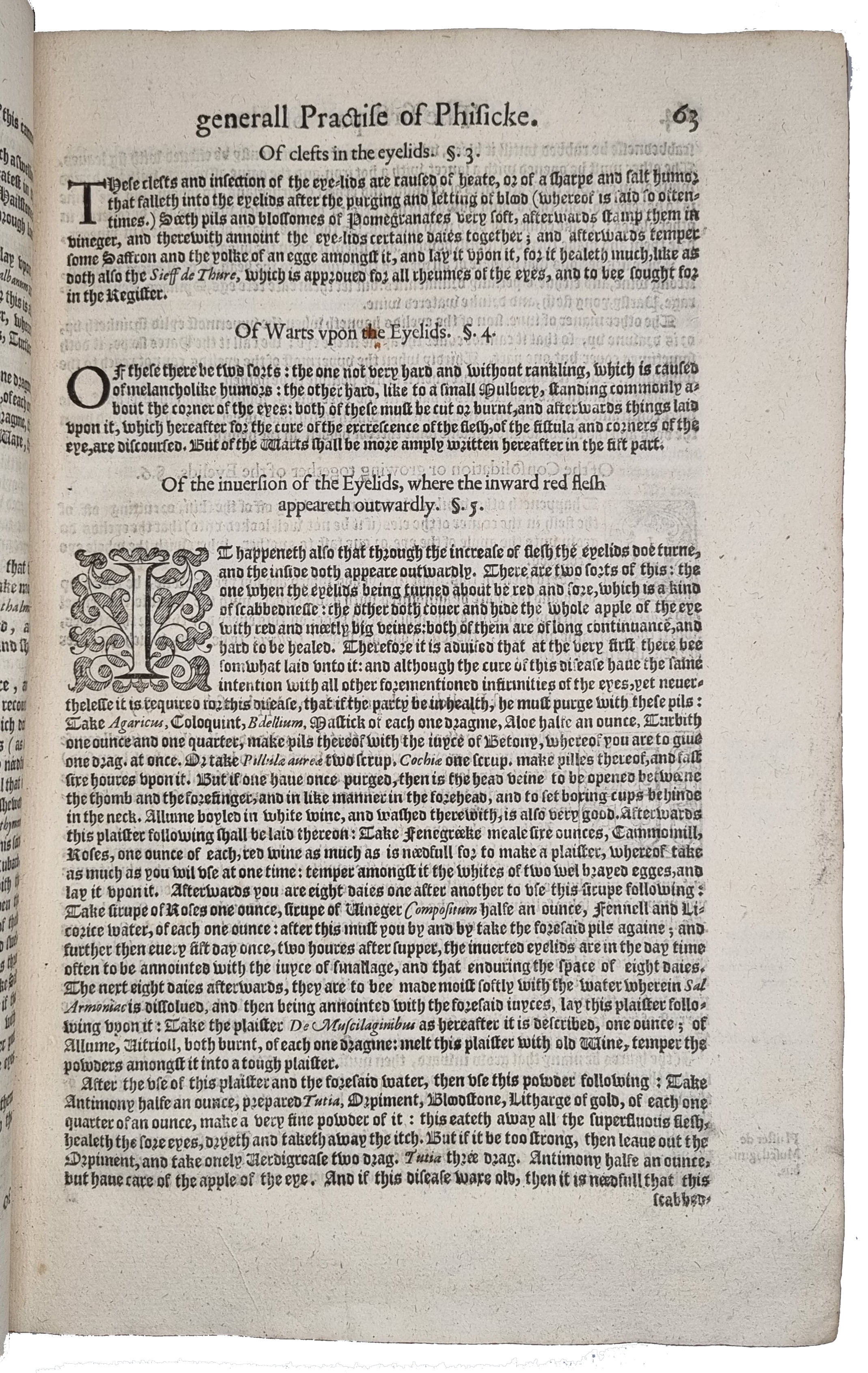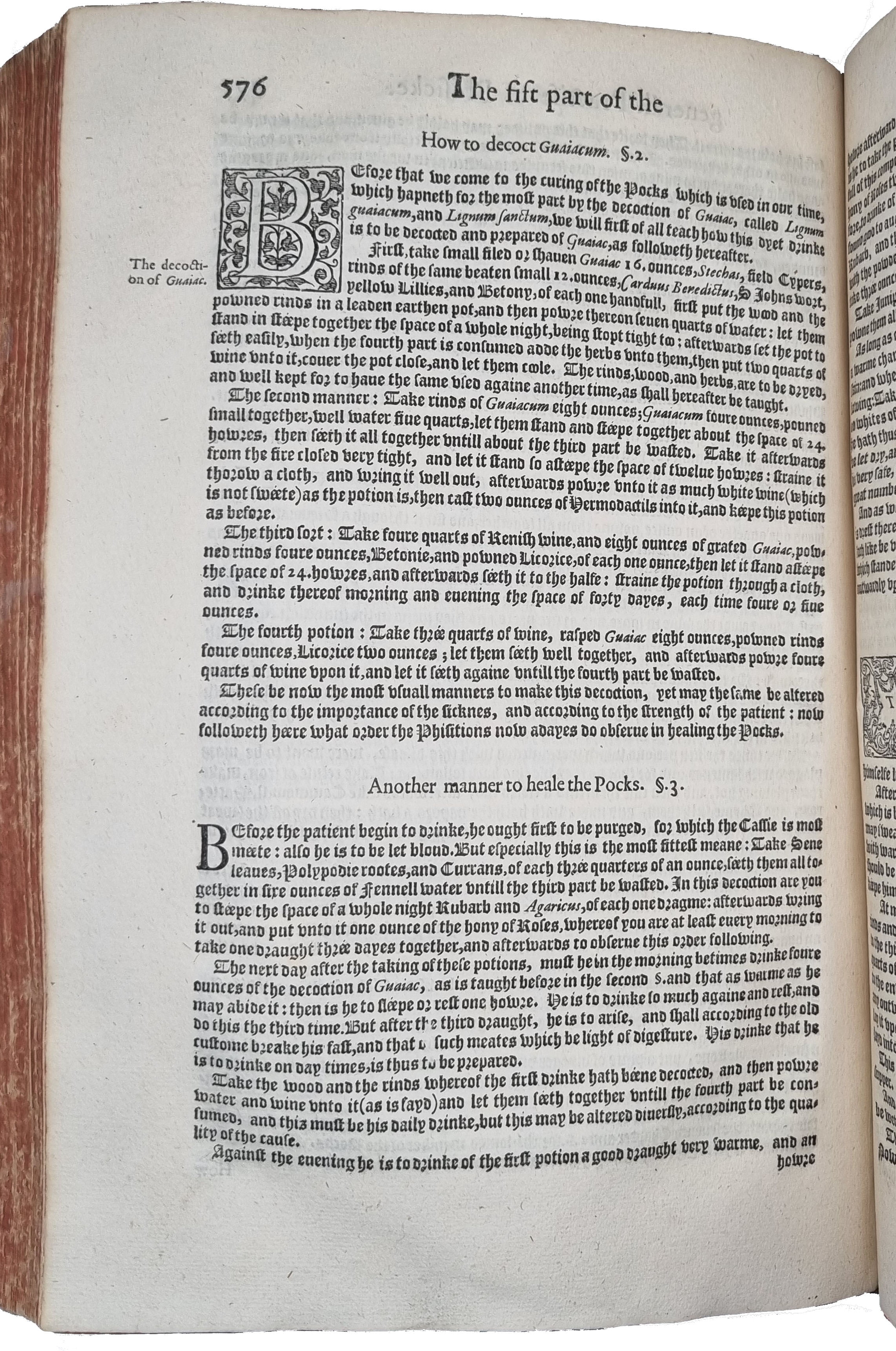WIRSUNG, Christopher.
The General Practise of Physicke
London, [J. Legat] for Thomas Adams, 1617.£3,750.00
Folio, pp. (xx) 790 (cxii). Black letter a little Roman and Italic. Woodcut floriated initials, printer’s device on title and typographical ornaments. “Pret Oct 1634” in manuscript at head of title page and pretium 10d in possibly earlier hand on f.e.p.. Small rust stain to pp. 137-144 gives way to a hole affecting a couple of letters on p. 139. Small marginal worm trail to gutter on pp. (xiii)-36, touching the text in a few places. Hh6 creased with some marginal fraying and ink soiling from the press. A very good, clean copy in early 17th century speckled calf, rebacked, gilt title and five raised bands, a.e.r..
Second edition of Jacob Mosan’s highly successful translation of Christopher Wirsung’s German-language medical treatise ‘Ein new Artzney Buch’.
Wirsung, the son of a wealthy merchant, was educated in Italy before returning to Germany to take over his family’s pharmacy, with his mother, after his father’s death in 1521. In addition to medicine, Wirsung put his education to use as a translator, writing the first German-language sonnet as a translation from an Italian sermon. He wrote his Artzney Book after beginning to organise his extensive recipe collection following his son’s death in 1562.
First published in Heidelberg in 1568, Wirsung’s work is ordered by the traditional “a capite ad calcem”, from head to foot, in the first four parts. These detail the nature and potential ailments of the head, chest, stomach, organs and limbs. Four further parts continue with details of skin diseases, fever, plague, poisoning, diet, and remedies. Instructions on the production and use of medicines are found throughout, whilst the eighth and final part focuses on the preservation and use of various foods and drinks such as wines, beers, oils, food, gold waters, spicebreads, marzipans and spices. In addition to medication and diet, the text advises a huge range of medical treatments for various ailments including enemas, baths, bloodletting, and plasters. Wirsung’s goal was to empower rural and uneducated people to heal themselves both through accurate diagnosis and healthy treatment. It is differentiated from other German medical texts of the era, which were mostly pharmacopoeias, by its focus on theoretical explanations of not just illnesses but of typical healthy function, making it more usable as a textbook to those without in-depth medical knowledge.
Several of his descriptions or advice are of particular historical interest, such as his treatment of madness as being divided into mania and melancholia—or, in modern parlance, manic and depressive. His treatment for infertility had also been noted: “Wirsung is inclined to a mode of thought which separated barrenness differently with regards to the sexes. To augment seed (not explicitly male), among the usual plant remedies he recommends the stones of ‘Buls, Cocks, Bucks, Rams, Bores and all their pissels’; for women, since the causes are more complex and largely humoural, the remedies vary greatly, though still relying in vegetative matter. In a short chapter at the end, spices and vegetables are supplemented by the ‘stone of a bore hog being two years old, and the pissel of a stag shaven small halfe an ounce, fower paire of Foxe stones, and fiftie or threescore Sparrowes braines’ added to many other ingredients to make a confection for both sees.” Alasdair A. MacDonald. ‘Scholarly Environments’.
STC 25865, ESTC S102810, Wellcome II 6760, Heirs of Hippocrates 237.5; National Library of Medicine 4755.In stock








